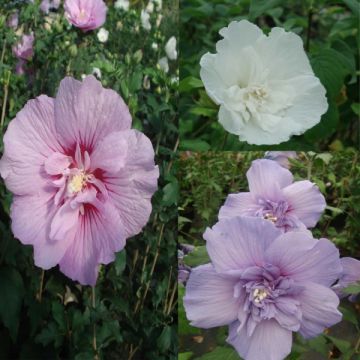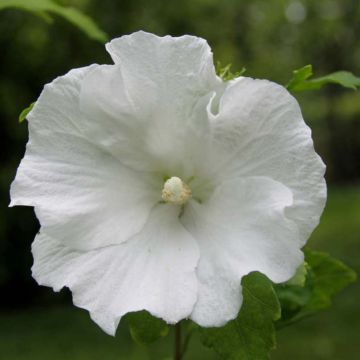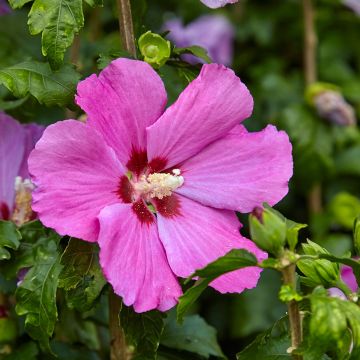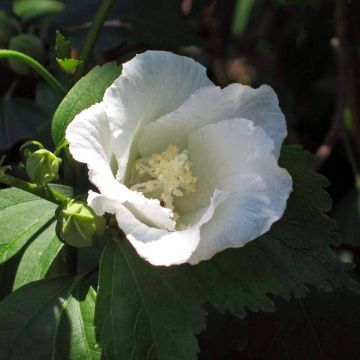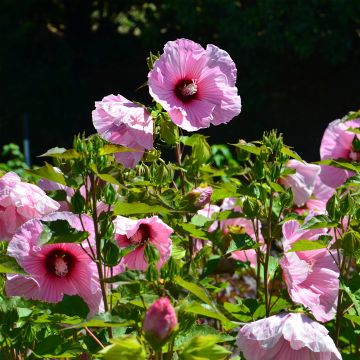

Hibiscus syriacus Tricolor - Althéa tricolore
Three-coloured Hibiscus syriacus
Hibiscus syriacus Tricolor
Common Hibiscus, Rose of Sharon, Syrian ketmia, St Joseph's rod, Garden Hibiscus
Special offer!
Receive a €20 voucher for any order over €90 (excluding delivery costs, credit notes, and plastic-free options)!
1- Add your favorite plants to your cart.
2- Once you have reached €90, confirm your order (you can even choose the delivery date!).
3- As soon as your order is shipped, you will receive an email containing your voucher code, valid for 3 months (90 days).
Your voucher is unique and can only be used once, for any order with a minimum value of €20, excluding delivery costs.
Can be combined with other current offers, non-divisible and non-refundable.
Why not try an alternative variety in stock?
View all →This plant carries a 24 months recovery warranty
More information
We guarantee the quality of our plants for a full growing cycle, and will replace at our expense any plant that fails to recover under normal climatic and planting conditions.
Would this plant suit my garden?
Set up your Plantfit profile →
Description
The Hibiscus syriacus Tricolour combines three different varieties of Altheas in one pot, benefiting from a multicoloured flowering: white, pink, and mauve. This ball of flowers made up of the intertwined stems of these 3 bushes will be perfect in a decorative pot to enhance a terrace or balcony. Called Tree Mallow because of the shape of its flowers, Hibiscus syriacus is exceptionally accommodating, tolerating cold and heat and will reward you with a long period of summer flowering.
The Hibiscus syriacus, or Garden Hibiscus or Tree Mallow, is a hardy, deciduous shrub in colder climates. In hot temperatures, it stays evergreen. It belongs to the Malvaceae family, which has more than 240 genera and 4200 species worldwide, except in very cold regions. This large family includes many ornamental herbaceous or shrubby genera, such as marshmallows or the countless hibiscus, and grand trees like the Lime or the Baobab with its massive trunk.
Hibiscus syriacus is a shrub from Asia, such as China and India. This shrub has produced many beautiful cultivars with flowers similar to the Hibiscus rosa-sinensis, its tropical relative. The cultivars available on the market offer a wide range of colours. Tricolour is a plant that offers three vivid colours in one pot: white, dark pink, and mauve flowers. (Varieties vary depending on available stock.) Each flower features dark red macules at the centre, adding to their beauty. These large corollas bloom consistently throughout summer, creating a stunning sight. The deciduous foliage is healthy and turns yellow in autumn. The leaves are simple, heart-shaped, and lobed, with toothed and undulating edges. The flowers, 8 to 10 cm (3.1 to 3.9 in) in diameter, are short-lived and last only 24 hours, but more are quickly produced. Tricolour is a unique plant with beautiful flowers and healthy foliage, making it a delightful addition to any garden.
The Tricolour Hibiscus is a robust plant that can withstand temperatures as low as -15°C (5 °F). It prefers full sun but can also grow in partially shaded areas in hot climates. It can adapt to most soil types, including limestone if planted in the ground. It only requires a few waterings in summer to support flowering and prevent leaves from prematurely turning yellow. However, a potted plant may need more frequent watering as it cannot draw water from deep within the ground. For best results, prune it reasonably short at the end of winter, ensuring that each variety is balanced to prevent one from dominating the others.
The Tricolour Hibiscus will be perfect for decorating a terrace or highlighting a curve in a path. Pair it with other potted plants, such as topiaries, like Ilex crenata Lingold, with its variegated evergreen foliage of bright yellow. In mild climates, Pittosporum tobira Nanum will also be a good companion; planted in a low pot, it will spontaneously form a compact ball with shiny green foliage, and its white spring flowering will charm you with its delicious fragrance. If you want to enhance the exotic aspect of your Hibiscus flowers, for example, plant it with a Dwarf Bamboo such as Shibataea kumasaca, with its wide and relatively short leaves, a beautiful bright green, which will form a lovely dense shrub.
Plant habit
Flowering
Foliage
Botanical data
Hibiscus
syriacus
Tricolor
Malvaceae
Common Hibiscus, Rose of Sharon, Syrian ketmia, St Joseph's rod, Garden Hibiscus
Cultivar or hybrid
Other Hibiscus
View all →Planting and care
You can optionally plant the Hibiscus syriacus Tricolour in open ground, in spring or autumn, by adding some compost and sand to your garden soil to improve its quality.
When using plants to decorate a terrace, balcony, or path, choosing the right pot is essential. A sturdy terracotta pot is a good option as it adds stability, thermal insulation, and a decorative touch. For those who prefer a plastic pot, it's best to choose one with two layers separated by an air gap to prevent compost heating. To keep the pot stable in windy conditions, add a few large stones to the bottom or a mix of soil from your garden and plant compost to increase its weight.
If you're planning to grow Altheas, it's essential to soak the root ball in a bucket before planting or repotting and then water it once you've planted it. To ensure the best results, choose a sunny location for your plant. If you live in a warm area, partial shade may also work. Don't worry if your plant starts to grow after May - this is normal.
Although Althaeas can tolerate heat and dry soil, they will look their best and produce more flowers if the soil retains moisture in the summer. You can mulch the base of the plant if necessary.
Planting period
Intended location
Care
Planting & care advice
This item has not been reviewed yet - be the first to leave a review about it.
Similar products
Haven't found what you were looking for?
Hardiness is the lowest winter temperature a plant can endure without suffering serious damage or even dying. However, hardiness is affected by location (a sheltered area, such as a patio), protection (winter cover) and soil type (hardiness is improved by well-drained soil).

Photo Sharing Terms & Conditions
In order to encourage gardeners to interact and share their experiences, Promesse de fleurs offers various media enabling content to be uploaded onto its Site - in particular via the ‘Photo sharing’ module.
The User agrees to refrain from:
- Posting any content that is illegal, prejudicial, insulting, racist, inciteful to hatred, revisionist, contrary to public decency, that infringes on privacy or on the privacy rights of third parties, in particular the publicity rights of persons and goods, intellectual property rights, or the right to privacy.
- Submitting content on behalf of a third party;
- Impersonate the identity of a third party and/or publish any personal information about a third party;
In general, the User undertakes to refrain from any unethical behaviour.
All Content (in particular text, comments, files, images, photos, videos, creative works, etc.), which may be subject to property or intellectual property rights, image or other private rights, shall remain the property of the User, subject to the limited rights granted by the terms of the licence granted by Promesse de fleurs as stated below. Users are at liberty to publish or not to publish such Content on the Site, notably via the ‘Photo Sharing’ facility, and accept that this Content shall be made public and freely accessible, notably on the Internet.
Users further acknowledge, undertake to have ,and guarantee that they hold all necessary rights and permissions to publish such material on the Site, in particular with regard to the legislation in force pertaining to any privacy, property, intellectual property, image, or contractual rights, or rights of any other nature. By publishing such Content on the Site, Users acknowledge accepting full liability as publishers of the Content within the meaning of the law, and grant Promesse de fleurs, free of charge, an inclusive, worldwide licence for the said Content for the entire duration of its publication, including all reproduction, representation, up/downloading, displaying, performing, transmission, and storage rights.
Users also grant permission for their name to be linked to the Content and accept that this link may not always be made available.
By engaging in posting material, Users consent to their Content becoming automatically accessible on the Internet, in particular on other sites and/or blogs and/or web pages of the Promesse de fleurs site, including in particular social pages and the Promesse de fleurs catalogue.
Users may secure the removal of entrusted content free of charge by issuing a simple request via our contact form.
The flowering period indicated on our website applies to countries and regions located in USDA zone 8 (France, the United Kingdom, Ireland, the Netherlands, etc.)
It will vary according to where you live:
- In zones 9 to 10 (Italy, Spain, Greece, etc.), flowering will occur about 2 to 4 weeks earlier.
- In zones 6 to 7 (Germany, Poland, Slovenia, and lower mountainous regions), flowering will be delayed by 2 to 3 weeks.
- In zone 5 (Central Europe, Scandinavia), blooming will be delayed by 3 to 5 weeks.
In temperate climates, pruning of spring-flowering shrubs (forsythia, spireas, etc.) should be done just after flowering.
Pruning of summer-flowering shrubs (Indian Lilac, Perovskia, etc.) can be done in winter or spring.
In cold regions as well as with frost-sensitive plants, avoid pruning too early when severe frosts may still occur.
The planting period indicated on our website applies to countries and regions located in USDA zone 8 (France, United Kingdom, Ireland, Netherlands).
It will vary according to where you live:
- In Mediterranean zones (Marseille, Madrid, Milan, etc.), autumn and winter are the best planting periods.
- In continental zones (Strasbourg, Munich, Vienna, etc.), delay planting by 2 to 3 weeks in spring and bring it forward by 2 to 4 weeks in autumn.
- In mountainous regions (the Alps, Pyrenees, Carpathians, etc.), it is best to plant in late spring (May-June) or late summer (August-September).
The harvesting period indicated on our website applies to countries and regions in USDA zone 8 (France, England, Ireland, the Netherlands).
In colder areas (Scandinavia, Poland, Austria...) fruit and vegetable harvests are likely to be delayed by 3-4 weeks.
In warmer areas (Italy, Spain, Greece, etc.), harvesting will probably take place earlier, depending on weather conditions.
The sowing periods indicated on our website apply to countries and regions within USDA Zone 8 (France, UK, Ireland, Netherlands).
In colder areas (Scandinavia, Poland, Austria...), delay any outdoor sowing by 3-4 weeks, or sow under glass.
In warmer climes (Italy, Spain, Greece, etc.), bring outdoor sowing forward by a few weeks.






























